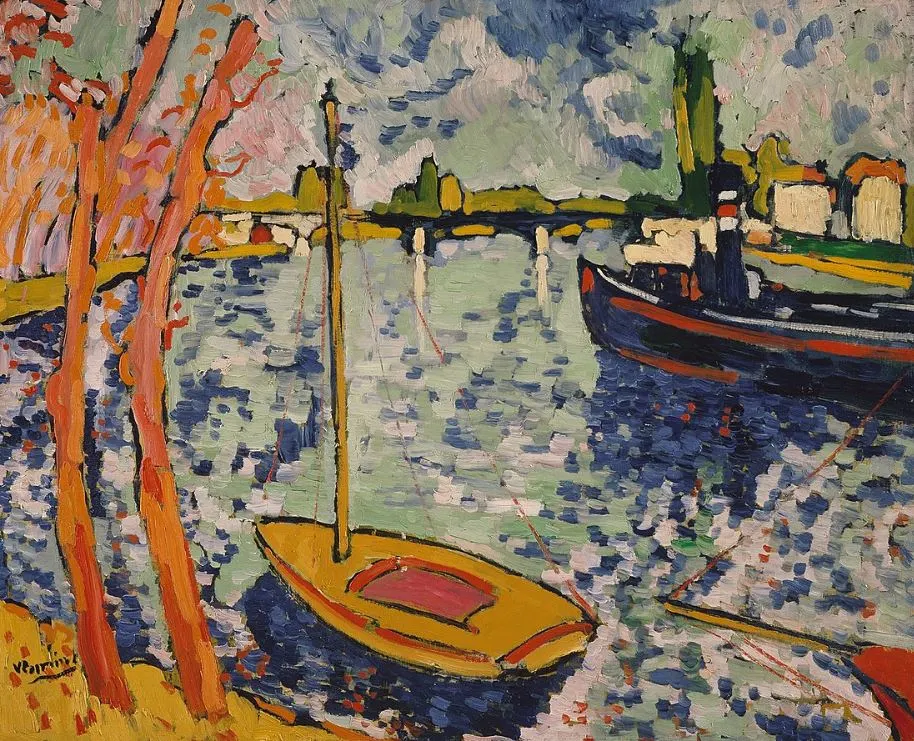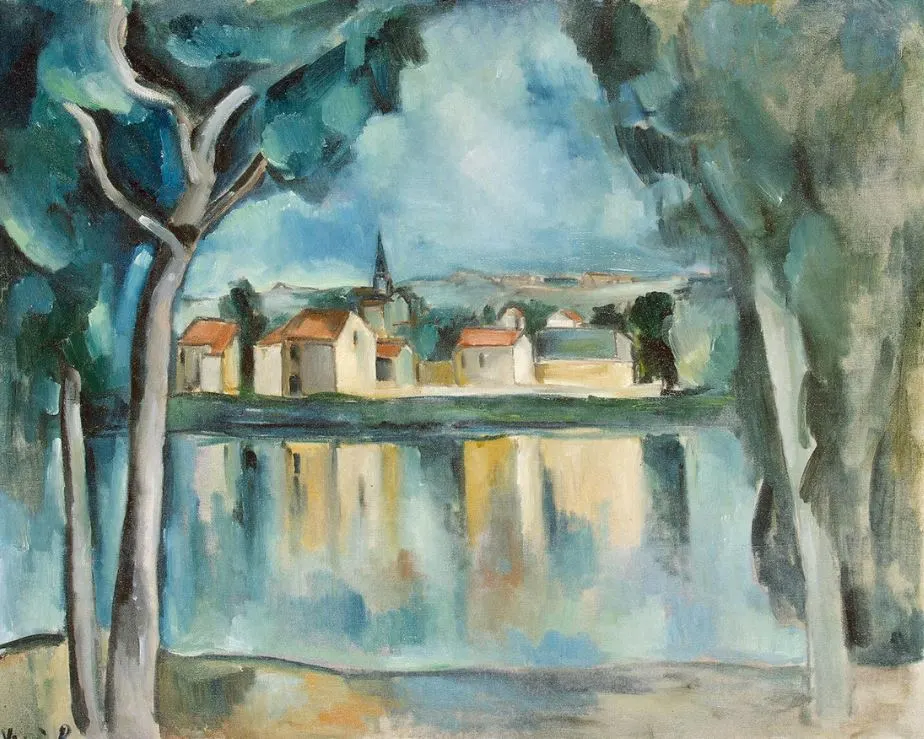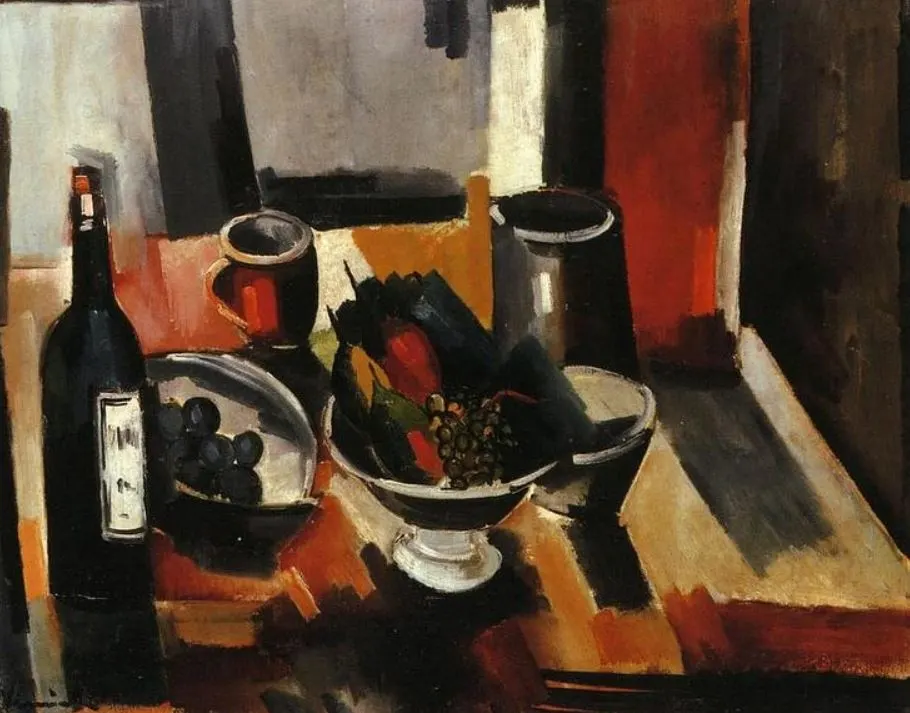When a group of Avant-Garde artists started using bold and unnatural colors to complete paintings in the early 20th century, they were referred to as the “Wild Beasts.”
Maurice de Vlaminck (1876-1958) was a French artist who was one of the leading painters of Les Fauves, a group of artists who radically changed the course of art history.
The Fauvism paintings he produced during this brief period in the first decade of the 1900s are by far the most famous works in his oeuvre.
He never appreciated the Cubist artists and their approach to art and he blamed Pablo Picasso (1881-1973) for the demise of Fauvism. This was a resentment he held for the rest of his life.
As his career progressed, he gradually gave up the color palette of his Fauvism period and predominantly produced works that resembled the style of Paul Cézanne (1839-1906).
Without further ado, let’s check out some of the most famous paintings by Maurice de Vlaminck.
1. Man with a Pipe
- Date created: 1900
- Dimensions: 72×48.5 centimeters
- Location: Centre Pompidou, Paris, France
Man with a Pipe is one of the earliest paintings of Maurice de Vlaminck, an artist who had a mother and father who played musical instruments. He only picked up painting in his late teens and experimented with a number of different techniques during his early years.
This painting was one of the works he completed before he adopted the Fauvism style that made him so famous. He used dark colors to paint this portrait of his father smoking a pipe and wild brushstrokes which make this work especially dramatic.

2. The Bar Counter
- Date created: 1900
- Dimensions: 40×32 centimeters (15.74 x 12.59 inches)
- Location: Calvet Museum, Avignon, France
The Bar Counter or “At the Bar” was completed around the same time and incorporates the same peculiar style of Maurice de Vlaminck’s early years. It depicts a red-haired woman sitting at a bar with a cigarette in her mouth.

This painting is believed to have been inspired by the paintings of Henri de Toulouse-Lautrec, one of the most renowned Art Nouveau artists in history. The subject matter was probably derived from his paintings of prostitutes and Parisian nightlife.

3. Portrait of André Derain
- Date created: 1906
- Dimensions: 27 × 22.2 centimeters (10.62 x 8.74 inches)
- Location: MET Museum, New York City, United States
The Portrait of André Derain depicts the man who played a major role in the career of Maurice de Vlaminck. He met André Derain (1880-1954) on a train to Paris following the end of his mandatory military duty when he was 23 years old.
This meeting resulted in a lifelong friendship that had its ups and downs over the years and even culminated in a quarrel that lasted 15 years. Both men were highly influential in the world of art in the first decade of the 1900s as leading figures of the Fauvism art movement.

4. Autumn Landscape
- Date created: 1905
- Dimensions: 46.2 x 55.2 centimeters
- Location: MoMA, New York City, United States
Autumn Landscape is another early work by de Vlaminck which was created at the height of the Fauvism art movement. It remarkably doesn’t feature the bright and vivid colors that were inspired by the paintings of Vincent van Gogh (1853-1890).
This work does hint at the interest of Vlaminck in the style of Paul Cézanne, a man who aimed to paint elements as simple as possible. This landscape features the same short brushstrokes that reduce elements to their basic geometric forms. This is very clear with the trees in this painting.

5. The River Seine at Chatou
- Date created: 1906
- Dimensions: 81.6 × 101 centimeters (32.12 x 39.76 inches)
- Location: MET Museum, New York City, United States
The River Seine at Chatou is one of the most famous paintings by Maurice de Vlaminck and one of his best-recognized works as well. It depicts the River Seine in Chatou, a suburb of Paris where he rented a studio with André Derain called the Maison Levanneur.
This building is located on the so-called “île des Impressionnistes,” a river island just west of Paris that became a popular spot for Impressionist artists to meet up and paint. De Vlaminck completed many of his most notable works here.

6. Tugboat on the Seine, Chatou
- Date created: 1906
- Dimensions: 50.2 x 65.1 centimeters (19.75 x 25.62 inches)
- Location: National Gallery of Art, Washington D.C., United States
Tugboat on the Seine, Chatou is another painting that was completed around the same time. This was a year after the Fauvism artist had their first controversial exhibition, the 1905 Salon d’Automne, which also featured works by Vlaminck.
Most of his paintings completed in 1905 and 1906 were inspired by the amazing works of art of Vincent van Gogh, the Dutch artist who transformed artworks into vibrating pictures. It was also inspired by Derain’s paintings produced in Southern France.

7. Houses at Chatou
- Date created: 1905
- Dimensions: 81.3 × 101.6 centimeters (32 × 40 inches)
- Location: Art Institute of Chicago, Chicago, United States
Houses at Chatou is perhaps the best example of van Gogh’s influence on de Vlaminck’s paintings. The loose brushstrokes using unmixed paint and elements that reflect the passion and temperament of the artist are clearly identifiable.
As the title of the painting suggests, it presents another view of Chatou in the western suburbs of France. Back then, however, Chatou was not yet absorbed by the metropolitan area of Paris and was basically a rural village. This work was probably one of those exhibited at the 1905 Salon d’Automne.

8. Town on the Bank of a Lake
- Date created: 1909
- Dimensions: 81.3 x 100.3 centimeters (32 x 39.48 inches)
- Location: Hermitage Museum, Saint Petersburg, Russia
Town on the Bank of a Lake is a painting that was completed at a time when the Fauvism art movement was pretty much already over. It only lasted between 1905 and 1908 and there were only 3 exhibitions in which Fauvism paintings were displayed.
This painting emphasizes the direction that Vlaminck went in for the rest of his career. He rejected the Cubist art movement and felt that artists went too far in disassembling and rearranging elements. He never got over it and once remarked that:
Picasso dragged French painting into a wretched dead end and state of confusion.

9. Still Life with Basket of Fruit
- Date created: 1918
- Dimensions: 72.8 x 92 centimeters (28.66 x 36.22 inches)
- Location: Private Collection
Still Life with Basket of Fruit is another painting that can be described as Maurice de Vlaminck’s ode to one of his greatest inspirations, Paul Cézanne. He completed several works depicting fruit such as “The Basket of Apples” (1893) at the Art Institute of Chicago.
The painting technique is strikingly similar as it also incorporates short brushstrokes that deconstruct the elements to their basic forms. The Cubists took it a step further and dissembled elements, a technique that became the foundation of abstract art. Vlaminck was especially vocal about his dislike of this.

10. The Red Tractor
- Date created: 1956
- Dimensions: 38×55 centimeters (14.96 x 21.65 inches)
- Location: Private Collection
The Red Tractor is one of the final works that Maurice de Vlaminck painted and was completed when he was about 80 years old. It’s hard to define this work in de Vlaminck’s overall oeuvre but emphasizes the loneliness of the man riding his farm vehicle.
His brushstrokes became a lot more compact and while this work features several colorful elements, the paintings of the final phase of his career often included a dark and somber color scheme. This was a great contrast with the paintings he completed while he was still a young and energetic artist in his mid-twenties.

